I’ve been monitoring a Red-tailed Hawk nest in the mountains of Tooele County for at least 7 years now. It isn’t close to the road and I don’t approach it on foot to avoid disturbing the hawks but I have a good view of it from my pickup through my long lens.
- This photo was taken at an effective 1120 mm and it’s been cropped significantly so I want to emphasize that I was nowhere near the nest. I strongly encourage others to avoid approaching nests of any species for any reason, raptors or otherwise.
This is what I could see early yesterday morning – the nest but no hawks. Red-tails have raised a family there each year since I’ve been watching it so this spring I’ve been keeping an anxious eye out for hawks to return to it. Each time I’ve been there I could see no hawks in the vicinity and yesterday the same was true on my first pass by the nest so I was quite disappointed.
The same pair of Red-tails will sometimes use the same nest in subsequent years but of course I don’t know for sure if it’s the same pair of birds using it the following year or not. I just like to see it being used for nesting each year.
Since the nest isn’t close and it’s always sidelit in the mornings and backlit later in the day photographing the hawks while they’re even close to it is extremely difficult and usually not worth the effort but in years past I’ve occasionally been lucky with one of them. I photographed this juvenile in the general vicinity of the nest about 6 years ago. As usual the bird was sidelit but in this case I think that kind of light was pretty dramatic, especially on this old snag of a perch.
Usually my efforts at photographing hawks near the nest are stymied by the difficult conditions but I still monitor it carefully each year just to watch for nesting success and to cheer them on.
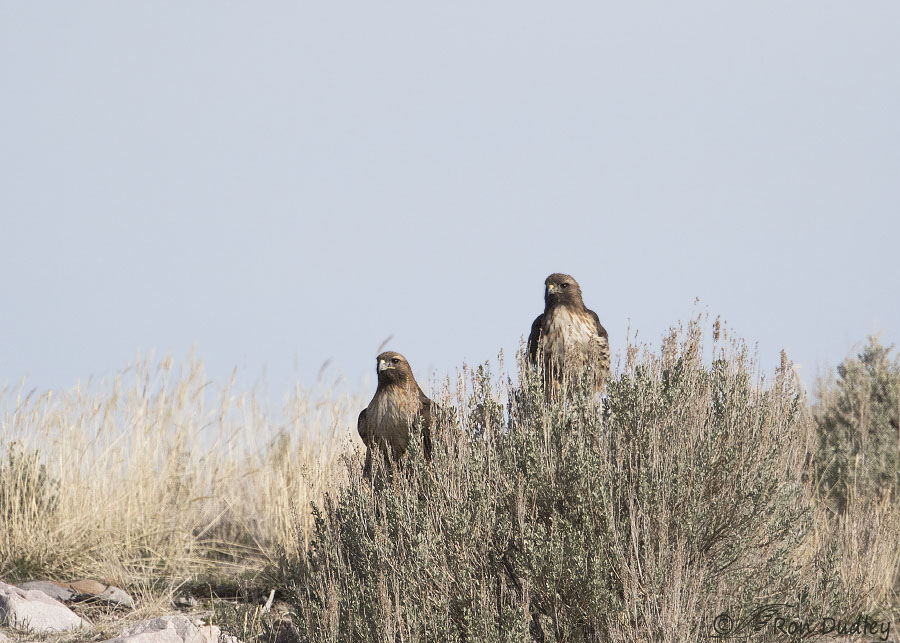
But yesterday morning I finally found an obviously mated pair of Red-tails in the vicinity of the nest on my second pass through the area and of course I was delighted, despite the fact that I never did get any great photos of either of them.
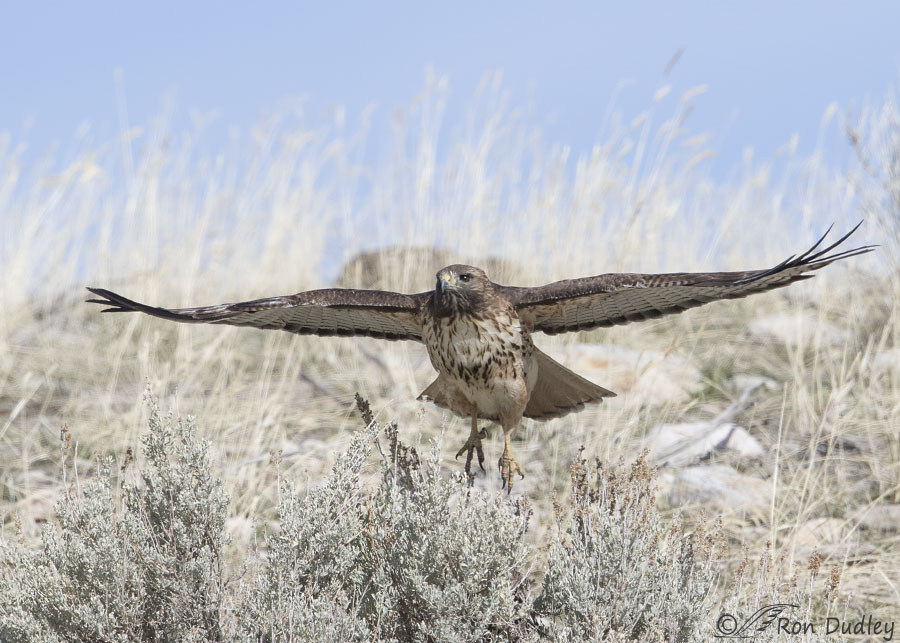
A few minutes later I did get a series of shots of one of them lifting off from a different perch in less than ideal light.
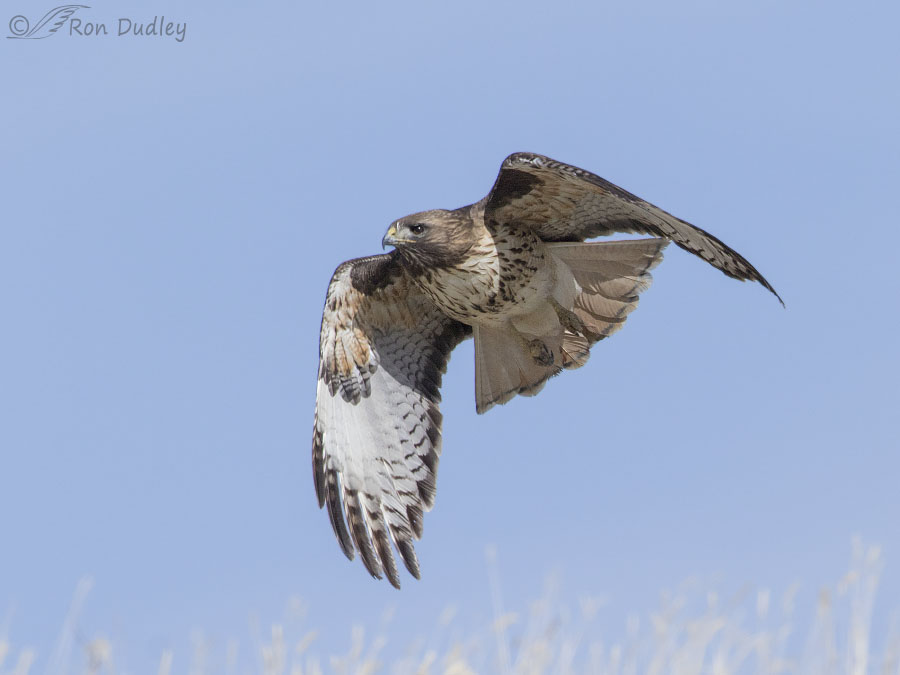
As the hawk cleared the horizon it turned to my left so the light angle improved a little and I was able to get a few photos…
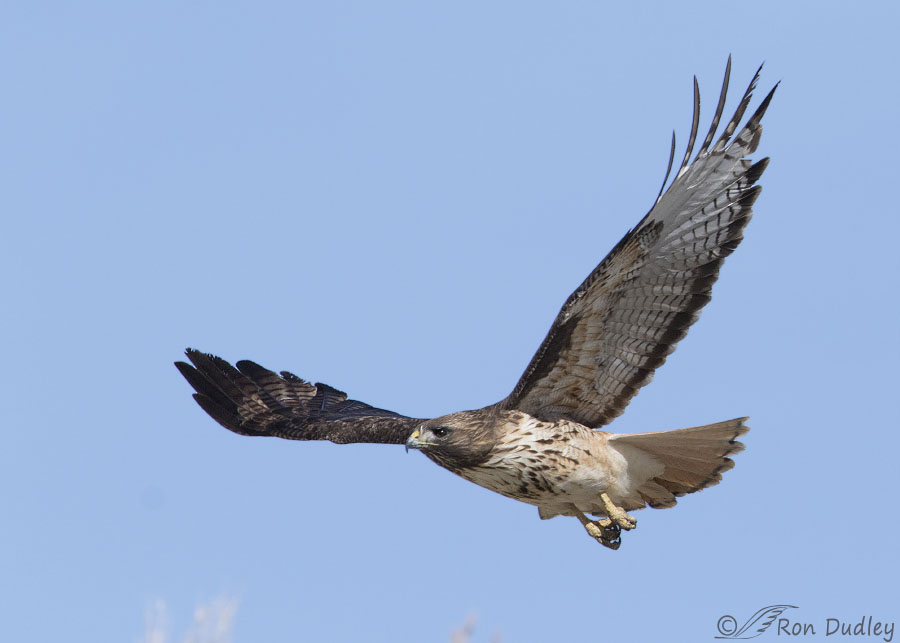
that weren’t too bad.
But mostly I was just happy to see them near the nest. I’m fairly confident that their intention is to raise a brood there this spring and I’m much relieved by that fact since it was beginning to look like it would go unused this year.
In-between my first and second pass by the nest I encountered another species in the mountains – Wild Turkeys. Once again I didn’t get any outstanding photos of them but they were in their breeding colors and boy did they look snazzy!
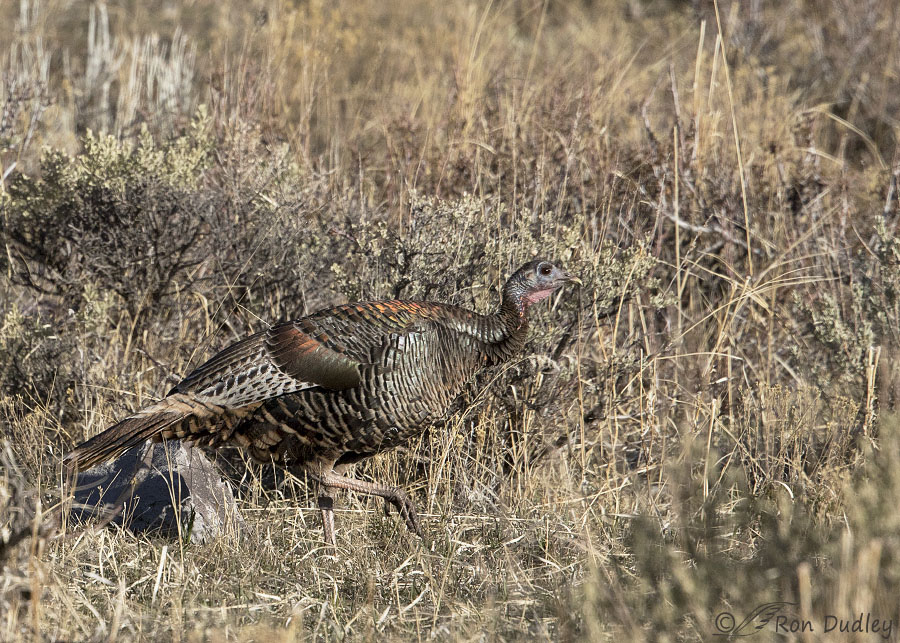
During the breeding season even the hens can show quite a bit of color. In Utah we have two subspecies of Wild Turkey – Merriam’s and Rio Grande. Merriam’s prefer mountain habitats and the Rio Grande subspecies prefers cottonwood bottoms so I’m fairly confident these were Merriam’s. But I could be wrong about that so if I am please let me know.
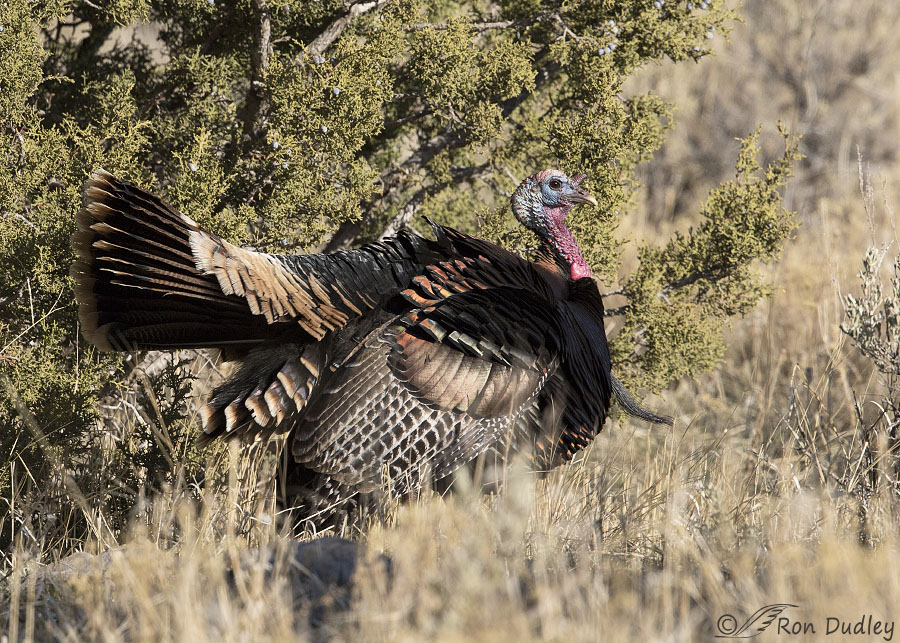
But the tom’s in their breeding colors are just spectacular this time of year. This one never did give me a full display from a good angle but this partial display really shows off his colors.
Wild Turkeys can be common in certain rural and agricultural areas and even some small towns in Utah but usually when I see those birds they’re in unnatural habitats and not in breeding colors so I was happy to catch these turkeys in a more natural juniper, pinyon and sagebrush setting and showing off their fine spring duds.
Ron
PS – I apologize for not including image techs this morning but I simply ran out of time.


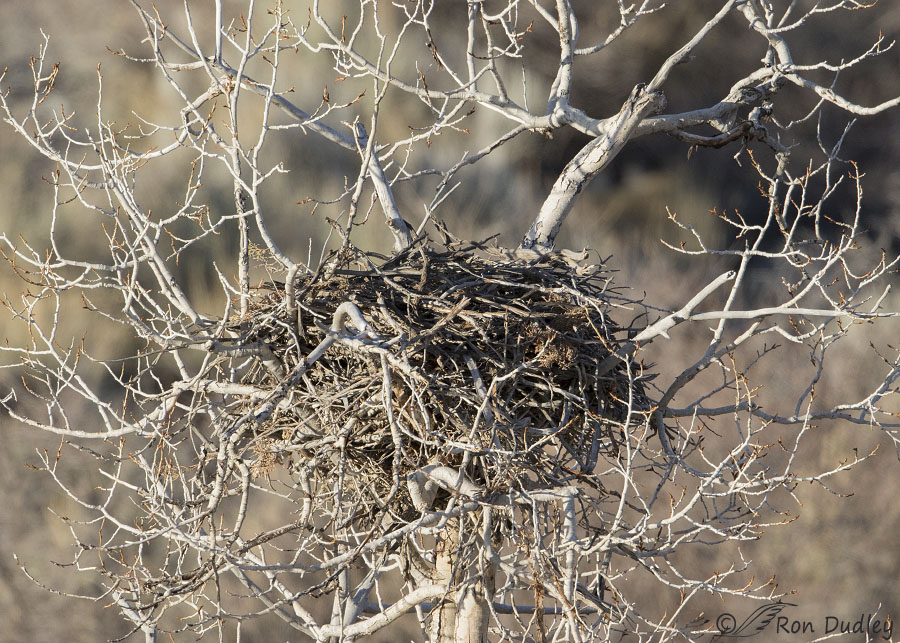
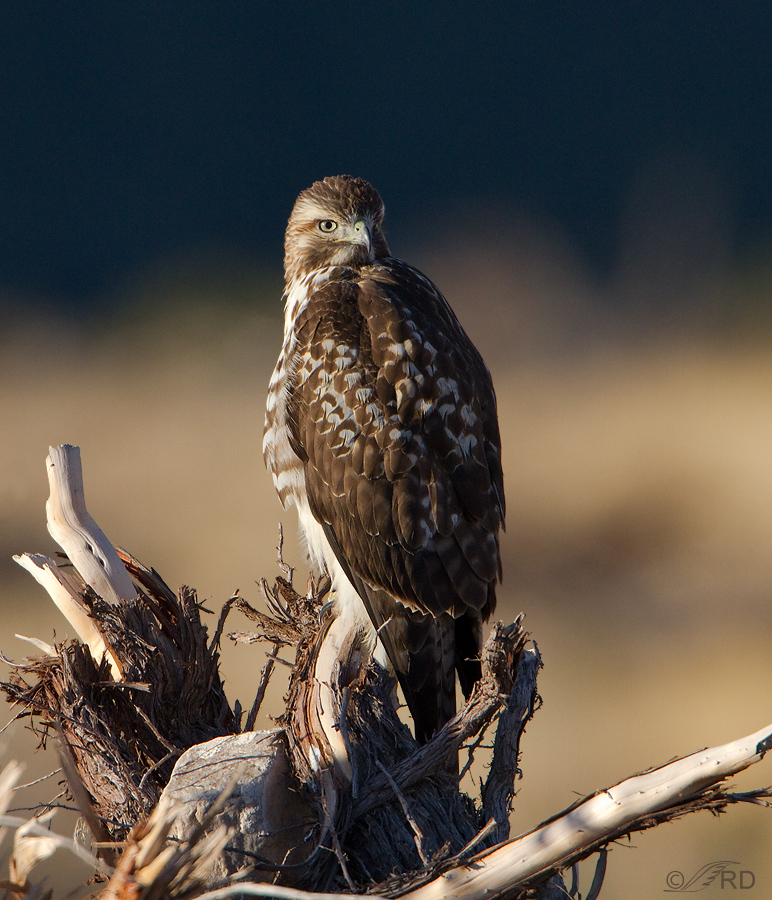
Great photos, I would love to see some wild turkeys!! any chance you can share where you were able to find these? Thanks so much
Ron
Beautiful shots of the birds, I enjoy photographing birds also and know how much work it can be to capture them in good light and habitat. We are extremely lucky to have one of the largest number of eagles on the east coast. They migrate thru the area and winter here in maryland. They congregate below the hydroelectric dam on the Susquehanna river. Great spot for photographing them. Good photographing to you!
Very nice and beautiful shots Ron D!
Fantastic series Ron!
Charlotte
Thanks, Charlotte.
OK, I think the shots of the redtails are glorious. Yes, I’m easy, especially with redtails, but still. They’re gorgeous.
A good indicator that a redtail nest is being refurbished for use is the addition of greenery, either evergreenery or otherwise. The local pair of redtails here don’t appear to be using the platform nest along the highway they used last year. They were hanging around here for a while, looking for a good place to raise a family, and evidently didn’t find one. I don’t yet know where they’re nesting, but I know they are. I might, or might not find them, but if I don’t, it will be OK. I know they’re nesting (and making more redtails) somewhere nearby.
Laura, I haven’t been able to see any greenery on this nest yet (and I have looked for it). But then I didn’t see any last year either, when I know it was used. It could have been there and I just didn’t notice it though. And besides, there still is very little green stuff in the area for them to choose from.
Yet again I am starting my morning with my mouth opened. I am so grateful to start yet another day in a complete state of feathered enchantment.
Megathanks.
Thank you, EC.
I have been watching some redtail nests for 4 years and this year I have not seen activity at 3 of the 5. One near my house in the city either blew down or was taken down this winter. I have seen the pair in the tree working building again. I know they have been successful rearing young for the last 4 years. I have seen more wild turkeys this past fall and winter than in my whole life added together. I did not know they had to be reintroduced. I am now curious about the story behind Utah’s turkeys (feathered species) and will be doing my homework.
April, You may be aware of a Box Elder raven nest on a power pole that was knocked down by the power company (I saw them doing it, I think last spring). This year the nest has been rebuilt and there are Red-tails on it. They aren’t incubating yet but I sure hope the power company doesn’t destroy this nest too.
April, you made me giggle-snort with: Utah’s turkeys (feathered species)
And I thank you!
Outstanding shots Ron, and thank you for reinforcing not to go near any bird nest suggesting not bother a nesting pair! The Red-tail pair look fantastic and I wish them luck and forbearance.
As I’m sure you know Vermont almost eliminated its Turkey population in the 1800’s and had to reintroduce Turkeys to the state. However, they have been quite successful even amongst the predators and human activity we have. The only downside from my point of view, certainly not from the Turkey’s view, is their scarcity at this time of year. In the late Fall and winter they are much easier to see.
Wonderful shots of both the Tom and hen.
Thanks, Dick. Turkeys had to be reintroduced in Utah too.
Beautiful Pictures. I am surprised at some comments about the turkeys being scarce. Wasatch Mountain Golf course have many and I’ve seen them in So. California on golf courses as well. They are quite numerous in other parts of the Wasatch Range.
Betty, Like is often (even usually) the case, a particular species is often scarce in some areas while common in others. Thank you.
The turkeys are gorgeous! I can see why Ben Franklin was so enamored with them. I sometimes go to a retreat center in the Santa Cruz mountains, but I’m there in May, so I only get to see the results of that breeding plumage when I go out hiking.
Glad the red tails look like they’re going to make use of that nest. I’ve been seeing the phoebes in my yard and my neighbor’s yard, but not sure where they’re nesting. Hopefully, they found a good spot.
Thanks, Marty. I actually think Franklin had a good point or two about his preference for our national bird.
I agree…until I see a shot like the one the plumber stole — then it’s eagles all the way!
That plumber still pisses me off. But he paid for his theft so I should get over it…
Ron, beautiful pictures of both. Lots of Red-tails here, but wild turkeys scarce. One time we were hiking and my Grand Canyon rim to rim hiking wife was well ahead of me and she who has no camera has two turkeys cross her path and of course by the time I get there they are long gone. In almost thirteen years living here I have yet to see one. Always look forward each morning to seeing your gorgeous photos. I had a beautiful large Osprey in an old dead tree yesterday and it was interesting to see a pair of Kestrels sitting on a limb close by, whereas two days before they flew away like shot out of a cannon when an adult Peregrine Falcon landed there. They obviously know the difference between a killer and a fisherman.
Everett Sanborn, Prescott AZ
“They obviously know the difference between a killer and a fisherman”
I like the way you said that, Everett.’
I don’t see turkeys as often as I expect to. They’re much more shy and elusive in the more natural habitats where I prefer to shoot than they are in some of our areas where they’re more common, especially in winter.
We have a pair of Red-tails around the lake where we go. I have an idea where the nest is but have yet to see it. That’s OK As for the turkeys, they parade down our street once and a while. Quite the show
As for the turkeys, they parade down our street once and a while. Quite the show
Have a great day
I hope your Red-tails have a successful nesting season, Diana – wherever their nest might be.
Turkey shots are spectacular….the colors, variety of feather patterns, iridescence….beautiful!!! Disappointed no red-tails…maybe later…..
Thanks, Patty. Perhaps you misunderstood part of my text – the Red-tails are there.
Didn’t read carefully enough…(dog has problems), looked at pictures and skimmed,..missed imp. Info….
No worries, Patty. Good luck with your pooch!
Hope your goggie is OK, Patty!
Snazzy, indeed ! This is the first time I’ve seen turkeys in breeding garb, and are they gorgeous ! Thanks for the look.
I don’t see them in breeding colors very often either, Kris. This was a fun sighting for me.
Glad the hawks appear to be returning and you got some shots of them. The one from 6 years ago is gorgeous! The wild turkey’s ARE beautiful in their breeding colors both the hen and the tom! Doesn’t appear we’ll have GHO’s nesting in the yard this year – can hear them at a distance, BUT!
The one from 6 years ago is gorgeous! The wild turkey’s ARE beautiful in their breeding colors both the hen and the tom! Doesn’t appear we’ll have GHO’s nesting in the yard this year – can hear them at a distance, BUT!
“Doesn’t appear we’ll have GHO’s nesting in the yard this year”
You just never know from year to year, do you, Judy. As far as I know the GHO’s on the MT family farm haven’t missed a nesting opportunity for many years now but it’s been a couple of years since I’ve been there to look for them.